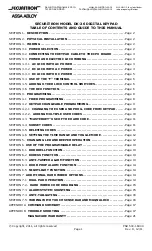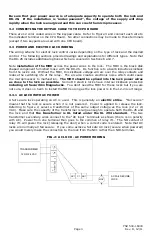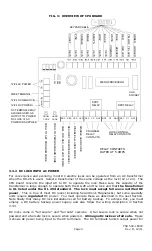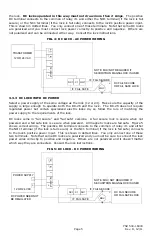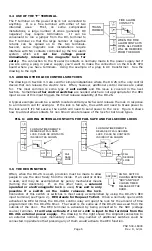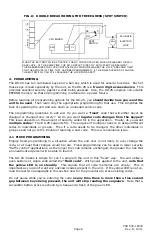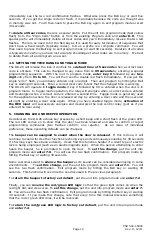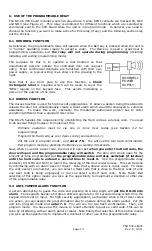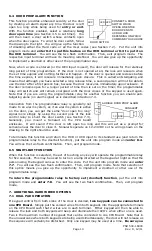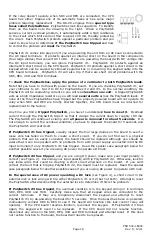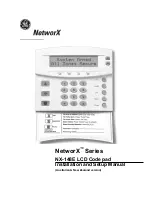
PN# 500-16900
Page 6
Rev. D, 12/11
3.4 USE OF THE “F” TERMINAL
The F terminal on the power strip is not connected to
anything. It is a free terminal with either of two
intended uses. First, on some complicated
installations, a large number of wires (generally DC
negative) may require termination. It can be
convenient to run a jumper from the DC- terminal to
the F terminal so that the large number of negative
returns can be spread on to the two terminals.
Second, some magnetic lock installations require
interface with NC contacts controlled by the fire alarm
system which will cut low voltage power
immediately releasing the magnetic lock for
safety. The connection to the fire alarm contacts is normally made in the power supply but if
you are using a plug in power supply, you’ll want to make the connection on the DK-26 CPU
board where you have terminals. Using the example of a plug in AC transformer. See the
drawing to the right.
3.5 ADDING OTHER LOCK CONTROL SWITCHES
The drawings in Section 3.3 are valid for simple installations where the DK-26 is the only control
device that can release the electric lock. Often, however, additional control devices are called
for. The most common is some type of exit switch and this issue is covered in the next
Section. Sometimes other control switches are needed which are not appropriate for the REX
input as use of this input triggers the timed release capability of the DK-26.
A typical example would be a switch located centrally which would release the lock in response
to an intercom call for example. If the lock is fail safe, the switch will need to break power to
the lock and if it’s fail secure, the switch will need to send power to the lock. Figure 6 shows
how to add external contacts for non timed remote release of the lock for both lock types.
FIG. 6: ADDING EXTERNAL CONTACTS FOR FAIL SAFE AND FAIL SECURE LOCKS
NC1
C1
AC
IN
F
DC I
N
/
O
UT
+
FAIL
SAFE
LOCK
+
C
NC
MOV
FOR NON-TIMED REMOTE
RELEASE OF FAIL SAFE
LOCK, PLACE NC CONTACTS
IN CIRCUIT AS SHOWN
NO1
C1
AC
IN
F
DC I
N
/
O
UT
+
FAIL
SECURE
LOCK
+
C
NO
MOV
FOR NON-TIMED REMOTE
RELEASE OF FAIL SECURE
LOCK, PLACE NO CONTACTS
IN CIRCUIT AS SHOWN
3.6 THE REX FUNCTION
Often, when the DK-26 is used, provision must be made to allow
people to use the door freely from the inside. If an electric strike
is used, exit may be accomplished by purely mechanical means
(turning the doorknob). If, on the other hand, a solenoid
operated or electromagnetic lock is used, free exit is only
possible if a switch on the inside releases the lock.
Connection of this switch or switches is most easily accomplished by using the DK-26's REX
input terminal (see Figure 2). REX stands for Request To Exit. When a normally open switch
activates the REX terminal, the DK-26's control relay will open the lock for the amount of time
programmed into the DK-26's timer. The result is the same as if the DK-26 was used from the
outside of the door. The REX terminal is activated by being connected to the SRC (voltage
source) terminal. It will also activate if +12 or +24V is input to the terminal from the
DK-26’s external power supply. The drawing to the right shows the simplest connection to
an external normally open momentary switch. Any number of additional switches could be
connected in parallel so that pressing any of them would activate the REX function.
AC
IN
F
D
C I
N
/
O
U
T
+
C
NC
TRANS-
FORMER
FIRE ALARM
CONTACTS
WHEN THE FIRE
ALARM CONTACTS
OPEN, ALL POWER
WILL BE REMOVED
FROM THE DOOR
SRC REX
AN N.O. SWITCH
CLOSING BETWEEN
"SRC" AND "REX"
CAUSES TIMED
RELEASE OF THE
DOOR.
Summary of Contents for Securitron DK-26
Page 23: ......


